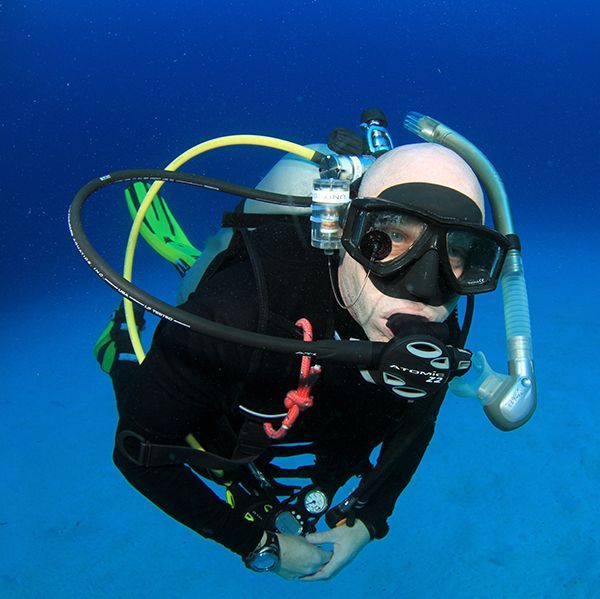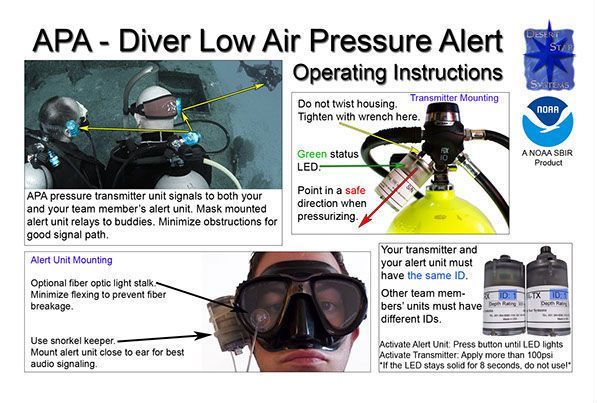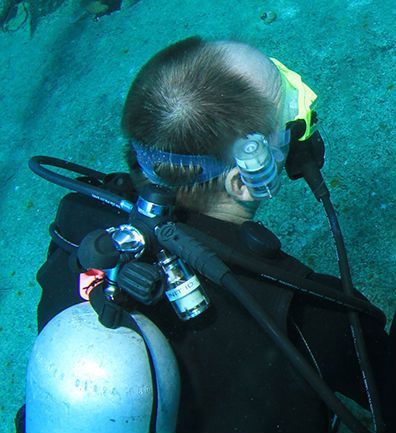Air Pressure Alert System
Team Level Air Reserve Management for Working Divers

Product Description
Air Pressure Alert System (APA) is an unobtrusive heads-up system specifically optimized to guard against low and out of air emergencies, a major cause of diving accidents. The APA device provides a major advance in team air management for professional divers and dive institutions. Unobtrusive and focused on the clear transmission of only the relevant information, APA is a hands-free, wireless design with multiple levels of redundancy. APA was developed and refined under the SBIR program.
This very easy to use two-component wireless system provides divers with a clear awareness of both their own air status and that of other divers in the team. The tank-mounted transmitter device uses ultrasonic telemetry to send air status to divers within tens of meters. The mask mounted receiver uses a bright light and loud audible signals to raise diver awareness even under difficult circumstances. Within the context of proper training and use, APA can provide all team members with continuous and near-automatic awareness of the air status of the entire team, thereby promoting a rational and safe conclusion of any working dive.
Key Features
-
Helps overcome typical factors leading to air emergencies among working divers: Task loading, poor dive conditions, buddy communication failures, inattention due to strong work focus, desire to complete a task or peer pressure leading to reduced air reserve margins
-
Hands-free operation with the alert unit attached to mask strap
-
Diver conditioning to continuous air reserve awareness through a periodic beep & blink while reserves are in OK region. Like a ticking clock on a wall, diver notices when signalling stops for any reason, prompting a gauge check
-
Simple, high-intensity audible and visual alert signals indicating the diver’s CAUTION or LOW reserves, and any other team members LOW reserve
-
Wireless operation with alert signal relay functions – effective range 10m-100m
-
Visual and audible alert signals noticeable by other team members directly
Important Materials
Reference Manual
Will an APA make a difference?
Class Instruction Guide & Quick Start Card
Systematic Protection Against Low Air Emergencies

APA works under and counteracts the circumstances that can lead to accidents including diver task loading, difficult dive conditions, over-concentration on task leading to inattention, diver communication problems or cutting of margins on account of a desire to complete work or peer pressure.
APA promotes the conclusion of any working dive on account of air reserves in an effective, consistent & rational fashion, reducing the chance of a diving accident.
Unlike devices such as air integrated dive computers with alert features, APA is a dedicated air reserve management device. Please review the tabs below to learn about the key characteristics of APA. A full set of information is available through the link at the bottom of the page.
Awareness Like the Ticking of a Clock

Gauge checks and even the alert signals of air integrated dive computers provide only intermittent reserve awareness, i.e. when a gauge check is done or when an alert is heard. This method of alerting can fail when an alert is not heard, a piece of gear fails or a gauge check is forgotten. Any of these conditions can set in motion the chain of events leading to an accident.
APA relies on a method of continuous awareness. When air reserve is OK, the alert unit provides a crisp beep and blink every 16 seconds. Like the ticking of a clock on the wall, the alert is noticeable but does not interfere. If no longer heard for whatever reason the diver quickly notices something is wrong and is prompted to check the gauge. The OK alerting also assures the diver will be able to perceive the subsequent CAUTION or LOW warnings, providing a check against hood or mask arrangements that might interfere with safety signal perception.
Heads-Up Wireless Design
This is the general comment by divers about the level of interference of APA with dive activities. The system is two-component, wireless and fully heads-up in its operation.
-
The pressure transmitter unit (APA-TX) screws into a high-pressure port on the first stage regulator. Activated by air pressure, it reads the pressure and sends an OK, CAUTION or LOW reserve report to the alert units as well as directly to other divers in range. The pressure range thresholds are factory programmed to reflect the standards of your dive organization.
-
The alert unit (APA-RX) is attached to the mask strap, where it is close to the diver’s ear. In response to pressure range telemetry signals from the diver and other team members, it issues both audible and visual alerts. The alert unit also works as a relay station, sending team member LOW reserve reports to other divers.
The head’s up method of APA provides a distinct safety advantage. All divers can continue working while staying appraised of air reserve status. Using the traditional methods relying solely on gauges, checks can be hard to do when busy handling gear, when exerted or when visibility is very poor. It is then not uncommon for divers to skip readings instead relying on mental tracking of air reserves – and providing an opening for accidents.
Redundant Audio Visual Alerts
Underwater working conditions are varied and can be adverse. Diver’s gear or tools can interfere with any single method of alerting. And, diver perception of sound and visual cues is highly individual and variable. For this reason, APA provides a redundant set of alerting mechanisms. Working together, the mechanisms combine to provide the maximum probability of alerting the diver to critical air reserve status information.
-
The alert unit emits loud audible alerts. Placed on the mask strap close to the diver’s ear, the signals are intense to the non-hooded warm water diver and clearly audible with a hood.
-
High-intensity LED to provide a strong visual signal. This method is in particular effective in dark or turbid conditions and when loud ambient noise due to tool use or similar might interfere with audible signalling. APA-RX also comes with a fibre-optic ‘light stalk’ with suction cup. Stick it on the mask for a peripheral view vision of the light signals even in bright conditions.
-
The high-intensity LED and the audible alerts are also easily spotted by other team members, providing another means of notifying to a diver that misses all alerts.
Information For The DSO: Why Use the APA System In Your Diving Program?
APA represents a new capability and a new product category in SCUBA diving. The following information for dive safety officers is provided by the system’s architect and chief designer, Marco Flagg.
DAN and other statistics show that low and out of air emergencies continue to occur at a persistent rate. A look at the circumstances shows that they are varied, affecting recently certified and experienced divers alike. Factors might include stress, high task loading, peer pressure, poor dive conditions, or simple preoccupation/inattention. Instructive among recent documents are the DAN Recreational Diving Fatalities Workshop Proceedings (2010), which identify “gas supply problems” as 41% of the triggers of diving fatalities and further specify that these problems resulted “mainly from inappropriate gas management”.
While developing APA under an SBIR contract for NOAA, I asked myself sceptically if a new product to address the issue of air reserve management was indeed needed, or if the real issue is quality of training and experience.
But over time, as we refined and simplified the system and dive tested it, I came to the conclusion that in an institutional dive setting at least, the capability provided by APA is in fact essential.
The situation might be compared to aviation. SCUBA diving is a similarly technology-supported activity, and the consequences of accidents can be severe. In aviation, a persistent rate of emergencies on account of low fuel situations, stalls and the like would be unacceptable however low it might be. And so, that industry long ago developed a combination of interlocking procedures and warning technologies that virtually eliminate risk factors once identified and have over the years resulted in dramatic safety gains in aviation.
By comparison, air reserve management continues to depend almost entirely on manual air gauge check by a diver who may be operating under difficult conditions, preoccupied with work, is subject to peer pressure, is stressed or is simply distracted. And, communication of air status to other team members in even more problematic as it first requires getting the buddy’s attention; not an easy task in many cases. Thus, the air reserve management now generally practised by divers provides only a sporadic awareness of air status – at those moments when the diver checks his/her gauge or actively communicates with a buddy. Viewed in this context, it is no surprise that low air emergencies do continue to occur as a diver fails to perform these manual checks or presses the limits for any number of reasons. And, with so many human factors involved, it is unlikely that training alone will be the solution.
The Principle Advantage of APA
APA provides the diver and all team members with continuous awareness of relevant air status. The device not only alerts a diver when she is low on air. By informing the diver actively when air status is still OK, the pattern of continuous awareness becomes the norm, naturally prompting the diver to check his gauge when no telemetry is temporarily available or indeed if the device fails entirely. By operating in a complete head’s up fashion, the diver can remain concentrated on the task. And, by relaying the low air status of any team member to all team members through multiple redundant mechanisms, dive operations can be concluded in a methodical fashion with sufficient air reserves.
